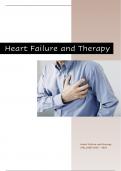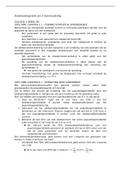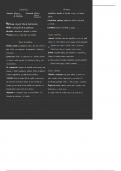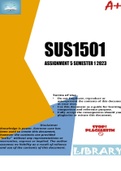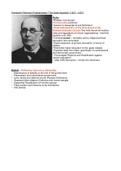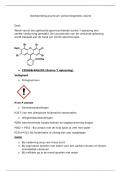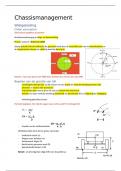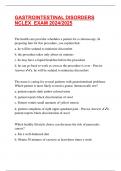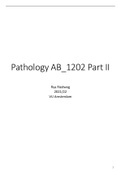Heart Failure and therapy
(AB_1026) 2022 - 2023
,Heart Failure and Therapy (AB_1026) 2022-2023
Inhoud
1.0 Physiology of the cardiovascular system ............................................................... 3
1.1 Excitation-contraction coupling ............................................................................ 3
1.1.1 Pacemaker cells....................................................................................................... 3
1.1.2 Action potential cardiomyocytes (CMs) ...................................................... 4
1.1.3 Ca cycling in the heart ........................................................................................ 4
1.1.3 Conduction system ................................................................................................ 5
1.2 The cardiac cycle ............................................................................................................ 5
1.2.1 Pressure ....................................................................................................................... 6
1.2.2 Volume ......................................................................................................................... 6
1.2.3 Cardiac output ......................................................................................................... 6
2.0 Diabetes, Obesity and vessel function ..................................................................... 7
2.1 Microvascular function .................................................................................................... 7
2.1.1 Myocardial ischemia ............................................................................................. 7
2.1.2 Acetylcholine............................................................................................................. 8
2.2 Diabetes and obesity ......................................................................................................... 8
2.2.1 Insulin and adipose tissue .................................................................................. 8
2.2.2 HFpEF ............................................................................................................................ 9
2.2.3 PVAT .............................................................................................................................. 9
3.0 Introduction to Heart Failure ......................................................................................... 10
3.1 Pressure volume diagram ......................................................................................... 10
3.2 Heart failure ................................................................................................................... 11
3.3 Function of cardiomyocyte ...................................................................................... 13
4.0 Translational studies in cardiomyopathies.............................................................. 14
4.1 Study 1 What is the role of titin and diastolic Ca2+ in active force
development ................................................................................................................................ 14
4.2 Study 2 PKA’s favorite son: prioritizing phosphorylation of
phospholamban over cardiac troponin I contributes to diastolic
dysfunction in hypertrophics cardiomyopathy .......................................................... 15
4.3 Study 3 microtubule remodeling leads to diastolic impairment in
HCM 16
5.0 Gene regulation in the cardiovascular system ...................................................... 18
5.1 Part 1 .................................................................................................................................. 18
5.1.1 Transcription........................................................................................................... 18
5.1.2 Epigenetics ............................................................................................................... 19
1
,Heart Failure and Therapy (AB_1026) 2022-2023
5.1.3 Splicing ...................................................................................................................... 21
5.1.4 Take home message ............................................................................................ 21
5.2 Part 2 .................................................................................................................................. 22
5.2.1 MicroRNA .................................................................................................................. 22
5.2.2 Long non-coding RNA (lncRNA’s) ................................................................. 23
5.2.3 CircRNA...................................................................................................................... 24
5.2.4 Take home message ............................................................................................ 24
2
, Heart Failure and Therapy (AB_1026) 2022-2023
1.0 Physiology of the cardiovascular system
1.1 Excitation-contraction coupling
Function of the heart:
o Pumping deoxygenated blood to the lungs
o Pumping oxygenated blood to all the organs in the body
o Together with blood vessels: providing adequate perfusion of all organs and tissue of the body.
Contraction and relaxation determine cardiac output. Contraction of the heart following electrical
stimulation of cardiomyocytes. The heart can beat independent of hormonal or neuronal input.
Automation
• Spontaneous active
• Pacemaker cells
1.1.1 Pacemaker cells
Pacemaker cells are specialized cardiomyocytes that are present in the SA node that spontaneously
fire to trigger each heartbeat.
The sodium (𝑁𝑎+ ) concentration and the calcium (𝐶𝑎2+ ) concentration on the outside of the
pacemaker cell in resting state is higher than on the inside of the cell. The potassium (𝐾 + )
concentration on the inside of the pacemaker cell in resting state is higher than on the outside of the
cell. To start an impulse the sodium channels open causing an influx of sodium. This causes a potential.
This lasts until the threshold (-40 mV) is has been reached. When this threshold has been reached, the
calcium channels open. This causes an influx of calcium. This lasts until a potential of +20 mV is reached.
To bring this potential down the potassium channels open and an afflux of potassium is created.
Heart rate determined by
o Resting membrane potential of SA node cells
o Velocity of depolarization: slope of the prepotential
Noradrenaline (NA) can be used to increase the potential faster and thereby increase the heart rate. It
does this by faster opening the sodium channels. This process is called sympathic stimulation.
Acethylcholine (Ach) can be used to increase the potential slower and thereby decrease the heart rate.
It does this by opening the potassium channels. This is parasympathic stimulation.
3

